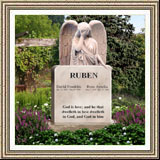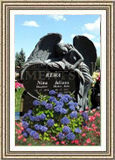|
The Significance of the Celtic Cross
By Yingtian Yang
There are many places in the United Kingdom and the
Republic of Ireland where you will see large numbers of
Celtic crosses. Many people confuse the Celtic cross
with the High Cross and the Irish Memorial Cross, but it
is completely different. The image of this cross is that
of a conventional Latin cross with a circle connecting
the stem and the arms. One usually associates this as a
symbol of the Irish missionaries, but since they are
found in England, Scotland and Wales as well as Ireland,
it is really seen as a symbol of early Christianity.
During the Dark Ages all of these locations did have
contact with Ireland.
No one knows for sure how the cross came to be or what
it really symbolizes. Some scientists have suggested
that the ring inside the cross represents the halo of
Christ and others believe it has its roots in the pagan
religions of the Celts and Druids who worshiped the Sun.
The crosses were erected in sacred places and were used
to declare adherence to the beliefs of Christianity.
Still other interpretations of the cross see the
straight lines representing man and the circle
representing woman. This is because a similar symbol
exists in Hindu tradition representing the union of man
and woman.
The early churches were very small, and since there was
always a cross in the churchyard, religious celebrations
often took place with the people gathered around the
cross. Based on the location of these crosses, though,
not all of them were erected for religious purposes.
Some may have been landmarks to show the way for
travelers on foot and others may have been used as
landmarks for those at sea either telling them that an
area was safe for landing or to denote dangerous areas
around the shoreline.
There are examples of this cross that date back 5000
years or more. According to legends, St. Columba
introduced this cross to Ireland and others say that St.
Patrick drew the circle in the cross to show a
connection between the pagan religion and Christianity.
The first crosses were on large rocks that laid flat on
the ground. The four arms of the cross could also denote
the four points of the compass.
The cross was decorated with carved designs and
intricate geometric shapes. Free-standing crosses were
very elaborate and were often made from four pieces of
stone - the base, the shaft, the head and the upper
cross arm - all of which were held together with mortar.
Celtic jewelry, displaying the cross, began to be made
in Ireland in the mid-1800's. Many people wore this
jewelry as a symbol of their faith. They were also being
placed in cemeteries and churches all over the United
Kingdom by 1890. Today, they rarely have any religious
significance as they are worn for their beauty. The
Celtic symbol of the cross is also used to denote
ancestry as being from the Celtic countries. Whatever
the original, it is clear that these early crosses were
the work of highly trained craftsmen. |





